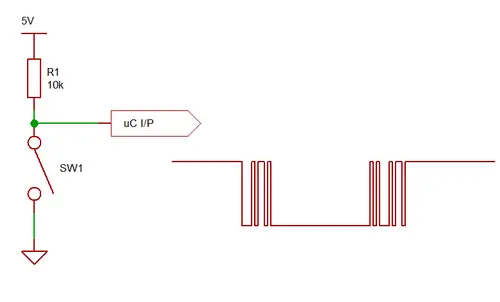How does a switch debounce circuit work?

A switch debounce circuit is used to eliminate or reduce the effect of contact bounce that occurs when a mechanical switch is pressed or released. Contact bounce refers to the rapid opening and closing of the switch contacts due to mechanical vibrations, resulting in multiple transitions being detected by the circuit.
Here’s a simplified explanation of how a switch debounce circuit works:
- Initial state: Assume the switch is open, and the circuit is in its idle state. The output of the switch debounce circuit is set to the corresponding state (high or low) based on the application’s requirements.
- Switch closure: When the switch is pressed, the switch contacts initially make and break contact several times due to bouncing. The debounce circuit detects these rapid transitions.
- Debouncing mechanism: The debounce circuit typically employs a combination of hardware and/or software techniques to ensure that only a single transition is recognized and processed. Some common debounce mechanisms include:
- a. RC Circuit: One common approach is to use an RC (resistor-capacitor) circuit. When the switch is closed, the capacitor charges through a resistor. The RC time constant determines the time it takes for the capacitor voltage to reach a stable level. During this time, any rapid fluctuations caused by bouncing will be averaged out, resulting in a clean signal.
- b. Schmitt Trigger: Another popular technique is to use a Schmitt trigger, which is a circuit that has hysteresis characteristics. It provides a stable output only when the input signal crosses specific voltage thresholds. The Schmitt trigger’s hysteresis helps eliminate the effects of bouncing, as the input must transition past the thresholds in a clean manner to trigger an output change.
- c. Software Debouncing: In some cases, software algorithms running on a microcontroller can be used to debounce a switch. These algorithms typically involve sampling the switch state at regular intervals and applying logic to determine the stable state based on the previous samples. This method can be advantageous when hardware resources are limited or when the debounce behavior needs to be adjustable.
- Stable state: After the debounce circuit processes the switch transitions, it settles on a stable output state, representing the correct switch status without the influence of contact bounce.
By using a switch debounce circuit, false switch transitions caused by contact bounce are eliminated or reduced, providing a more reliable and stable input to the downstream circuitry or microcontroller.
mixos Edited answer 7 June, 2023

